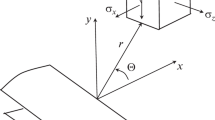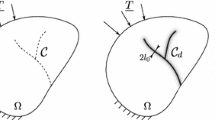Abstract
The initial energy release rate for a branch crack propagating at an arbitrary angle from an existing crack tip is obtained in a simple fashion and in closed form by using a continuity assumption. It is then postulated that the branch crack propagates in the direction which causes the energy release rate to be a maximum and that initiation occurs when the value of this release rate reaches a critical value. It is shown that these postulates yield results identical to the maximum stress theory, since the direction in which the maximum circumferential stress occurs is also the direction causing the maximum energy release rate.
Résumé
La vitesse de relaxation de l'énergie initiale d'une fissure arborescente qui se développe suivant un angle arbitraire au départ de l'extrémité d'une fissure préexistante est obtenue sous une présentation simple et une forme fermée en utilisant une hypothèse de continuité. On postule donc que la fissure latérale se propage dans la direction correspondant à un maximum de relaxation de l'énergie, et que l'amorcage se produit lorsque la vitesse de relaxation atteint une valeur critique. On montre que ces postulats conduisent à des résultats identiques à ceux de la théorie de la contrainte maximale, puisque la direction suivant laquelle se présente la contrainte circonférentielle maximum est également celle suivant laquelle la vitesse de relaxation de l'énergie est maximale.
Zusammenfassung
Die Anfangsgeschwindigkeit der Energiefreilassung für einen Zweigriβ, der sich unter einem willkürlichen Winkel von einer bestehenden Riβspitze ausbreitet, wird unter einer einfachen Darstellung und in einer geschlossenen Form durch Gebrauch einer Kontinuitätsannahme aufgestellt. Es wird dann vorausgesetzt dass der Zweigriβ sich in der Richtung ausbreitet welche ein Maximum der Energiefreilassungsgeschwindigkeit bewirkt und dass die Riβauslösung eintritt wenn der maximum Wert dieser Energiefreilassungsgeschwindigkeit einen kritischen Wert erreicht. Es wird gezeigt dass diese Annahmen zu den selben Ergebnissen wie die der maximalen Spannungstheorie führen, da die Richtung der maximalen Kreisspannung dieselbe ist als die der maximalen Energiefreilassungsgeschwindigkeit.
Similar content being viewed by others
References
G. C. Sih, A special theory of crack propagation, Methods of Analysis and Solutions of Crack Problems, Noordhoff International Publishing (1973).
G. C. Sih, Some basic problems in fracture mechanics and new concepts, Engng. Fracture Mech., 5 (1973) 365.
K. Palaniswamy, Crack propagation under general in-plane loading, Ph. D. Thesis, California Institute of Technology (1972).
F. Erdogan and G. C. Sih, On the crack extension in plates under plane loading and transverse shear, Trans. ASME, J. Basic Engng., 85 (1963) 519.
M. L. Williams, On the stress distribution at the base of a stationary crack, Trans. ASME, J. Appl. Mech., 24 (1957) 109.
G. C. Sih and H. Liebowitz, Mathematical theories of brittle fracture, Fracture, An Advanced Treatise, Vol. 2, Academic Press (1968).
M. L. Williams, Stress singularities resulting from various boundary conditions in angular corners of plates in extension, Trans. ASME, J. Appl. Mech., 74 (1952) 526.
A. A. Griffith, The phenomena of rupture and flow in solids, Phil. Trans. R. Soc., A 221 (1921) 163.
Author information
Authors and Affiliations
Rights and permissions
About this article
Cite this article
Nuismer, R.J. An energy release rate criterion for mixed mode fracture. Int J Fract 11, 245–250 (1975). https://doi.org/10.1007/BF00038891
Received:
Issue Date:
DOI: https://doi.org/10.1007/BF00038891




